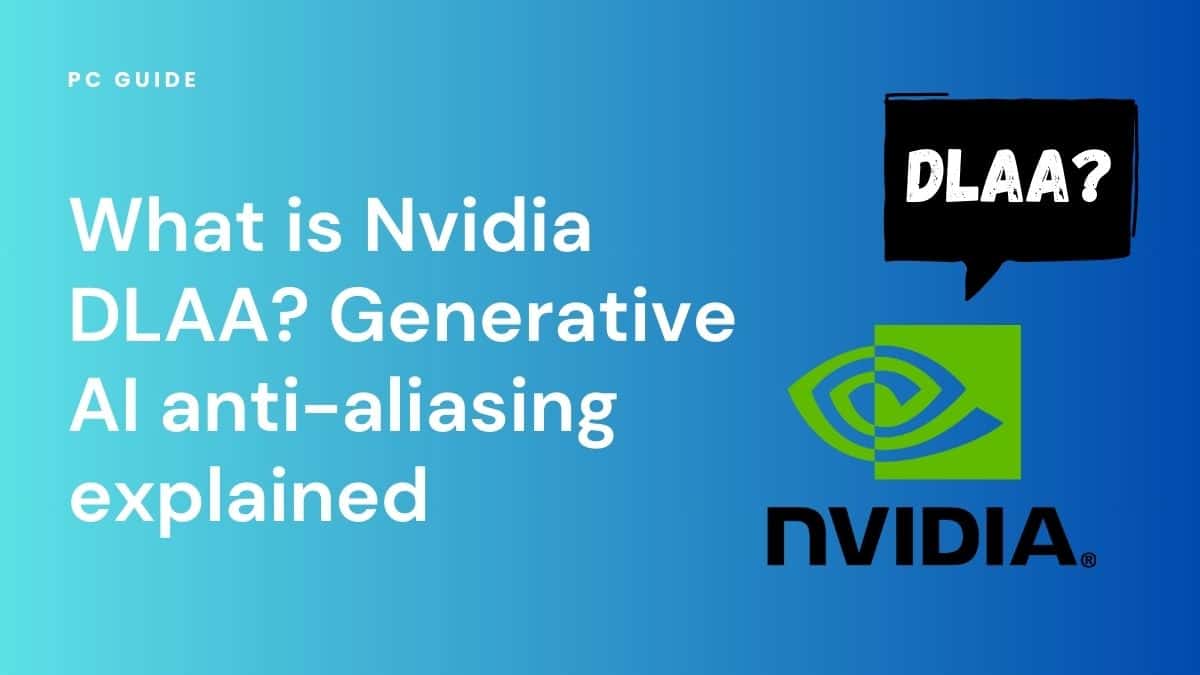What is Nvidia DLAA? Generative AI anti-aliasing explained

Table of Contents
In this guide, we will explain everything you need to know about Nvidia DLAA, ensuring a detailed understanding of this remarkable Nvidia feature. This article will cover the fundamental concepts of Nvidia DLAA, delving deep into its working mechanism, and elaborating on the unique benefits it brings to your gaming experience.
Nvidia DLAA is an innovative AI-driven anti-aliasing feature exclusively tailored for Nvidia’s RTX graphics cards, aiming to enhance your gaming adventures. This cutting-edge technology is built on the same foundational tech as Nvidia's globally acclaimed DLSS, yet it presents distinctly different outcomes. Unlike other technologies that often compromise image quality for enhanced performance, DLAA stands out by boosting the final image quality in games without cutting corners.
What is Nvidia DLAA?
According to Nvidia, DLAA (Deep Learning Anti-Aliasing) is a high-end technique that provides superior image quality for all GeForce RTX GPUs by using AI-based anti-aliasing algorithms. This cutting-edge technology utilizes the same Super Resolution technology that was meticulously developed for DLSS, aiming to reconstruct a native resolution image to maximize image quality. DLAA stands out by enhancing the visual finesse of games, delivering images that are more refined and lifelike.
Nvidia DLAA is a dedicated anti-aliasing feature that operates on the same pipeline as Nvidia's acclaimed Deep Learning Super Sampling (DLSS). Essentially, it’s DLSS minus the upscaling part. Instead of magnifying the image, Nvidia employs its sophisticated AI-assisted technology to improve anti-aliasing at the native resolution. This technology is instrumental in addressing aliasing in video games, a common issue where diagonal lines on the screen create a blocky and stair-stepping effect, known as “jaggies”. Anti-aliasing techniques, such as DLAA, aim to bridge the gaps between pixels, resulting in smoother edges on objects and an overall enhanced visual and frame rate experience in gaming.
How does DLAA work?
DLAA works by applying the same groundbreaking techniques used in Nvidia DLSS, albeit differently. While DLSS primarily focuses on upscaling images, it’s essentially an anti-aliasing technique at its core. This similarity makes understanding DLAA a lot more straightforward, as it offers the anti-aliasing component without the added layer of upscaling. It's a streamlined, direct approach to improving image quality, honing in solely on anti-aliasing to deliver clearer, crispier visuals.
Delving deeper, DLAA operates by harnessing an AI model and the dedicated Tensor cores present in Nvidia's RTX graphics cards. Nvidia meticulously trains this AI model by presenting it with low-resolution, aliased images produced by the game engine, along with motion vectors from the same low-res scene. In this phase, the AI model meticulously compares the low-resolution image to a high-quality 16K reference image, learning to identify and correct imperfections to enhance the final image quality substantially. This AI-driven process ensures images are free from the jarring ‘jaggies’, offering gamers a more visually polished and immersive gaming experience.
There are three main anti-aliasing techniques that are usually used: temporal anti-aliasing (TAA), fast approximate anti-aliasing (FXAA), and multi-sampling anti-aliasing (MSAA). FXAA is the least demanding, only sampling pixels once in your current frame, which also makes it much faster than its counterparts. TAA also only samples pixels once but references past frames for increased accuracy. Finally, MSAA is the most demanding, taking a sample of each pixel at multiple points before creating an average for higher levels of image quality. DLAA works similarly to TAA, but instead of sampling every pixel, it only samples pixels that have changed from one frame to the next to fill in the missing information.
The benefits of DLAA
DLAA stands out by delivering exceptional anti-aliasing outcomes while maintaining a higher degree of the original image's detail compared to traditional methods and even NVIDIA‘s renowned DLSS. The core of its effectiveness lies in its machine learning foundation. This technology applies a refined understanding of real-world object appearance to the aliasing issue, ensuring more accurate and visually appealing results. DLAA not only focuses on eliminating jaggies but also enhances the overall image quality, making every frame more lifelike and closer to the intended artistic vision.
Moreover, DLAA aims to boost visual fidelity with a lesser performance toll compared to standard anti-aliasing techniques. It leverages the same dedicated machine learning hardware utilized by DLSS upscaling to expedite its image processing. Though DLAA inevitably entails a performance impact, it is significantly milder than what traditional methods would impose for comparable or even inferior results. The balance of improved visual output and maintained performance efficiency makes DLAA a promising advancement in gaming graphics technology. To experience the visual performance boost firsthand, we’ve outlined the best GPUs for Nvidia's DLAA in Cyberpunk 2077.
Should I turn on Nvidia DLAA?
Yes, you might opt for DLAA over DLSS particularly when your GPU boasts sufficient power to smoothly run a game at your desired resolution and framerate, and you wish to boost the image quality by reducing aliasing artifacts. DLAA serves as an excellent tool in such situations, enabling you to uphold your current resolution while significantly enhancing the overall image clarity and quality.
What GPU supports DLAA?
All RTX 40 series GPUs support DLAA. The technology is incorporated into DLSS, offering both Super Resolution and DLAA, ensuring higher image quality and anti-aliasing support for all Nvidia RTX GPUs.
